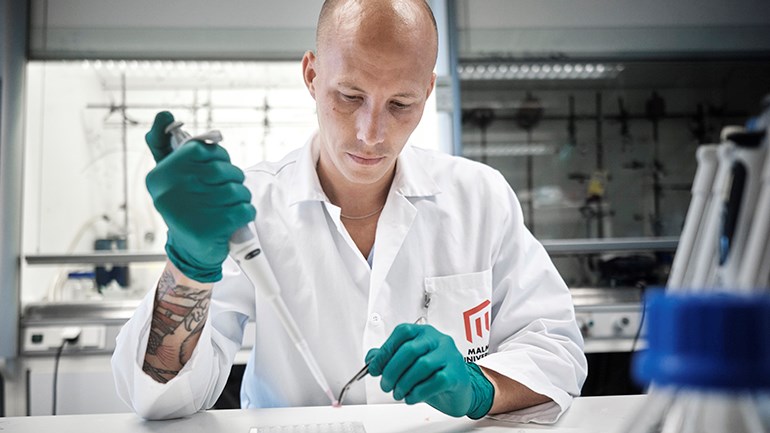Growing 3D cells provides a better picture of reality

Thomas Sjöberg, project assistant at the department of biomedical science
How do viruses enter and multiply in our cells? Researchers at Malmö University have developed a model for growing lung cells in 3D that reflects what the cells in the human body look like. The results could be a first step towards understanding what kind of drugs or molecules are required to stop viruses.
Researchers Thomas Sjöberg and Anette Gjörloff Wingren have studied how virus proteins from SARS-CoV-2 attach to lung cells. They have compared cultures of human lung cells in both 2D and 3D models to study differences in how each model binds protein.
The cells in our lungs the coronavirus encounters have a certain shape and that is not reflected in 2D models.
Thomas Sjöberg
In a 2D model, cells grow next to each other in a flat layer. Cells in a 3D model can grow in three-dimensional structures that mimic their natural growth pattern.
Since they could not test with live viruses, but only with viral proteins, the focus has been on the receptor, the part of the cell that the virus uses to enter the cell. It turned out that the 3D model gave a much more accurate picture of what the cells really look like, that is, their morphology.
“The cells in our lungs the coronavirus encounters have a certain shape and that is not reflected in 2D models. If you want to test how cells react to medicines or viruses, you want cells to reflect what it looks like in the human body. Otherwise, the test can give a very inaccurate answer,” says Sjöberg.
Sjöberg has developed existing protocols for 3D cultures of lung cells, tested different cell types and, together with colleagues, performed staining to visualise the cell cultures in the best possible way.
“We saw that 3D-grown cells had developed a greater number of the receptors that viruses use than 2D-grown cells. We interpret this to mean that the 3D model is better at catching viruses because it more closely resembles what it looks like inside the human. When growing in 2D, the cell cannot do that, says Gjörloff Wingren, a professor of biomedical laboratory science.
The goal of establishing a protocol is to achieve the same results on each test. The unique thing about the study is that Sjöberg managed to achieve the same results in many repeated and extensive cultivations, which means that the protocol is very reliable.
Even though the researchers developed the model specifically for the coronavirus, it can also be used to, for example, study asthma medications, COPD and other lung diseases. The 3D model can contribute to increasing knowledge about how different viruses infect our cells, and the study shows how important it is to develop tools for virus studies that can be used in the laboratory.
“The goal is for other research groups to be able to repeat what we have done in a simpler way using our protocol,” says Sjöberg, with Gjörloff Wingren adding:
“If other research groups and the pharmaceutical industry are interested, we can develop these models or similar according to their needs.”
Text: Magnus Jando & Adrian Grist